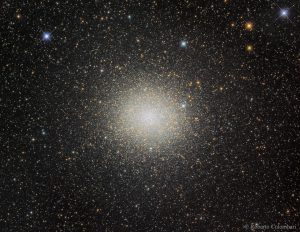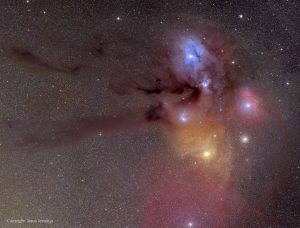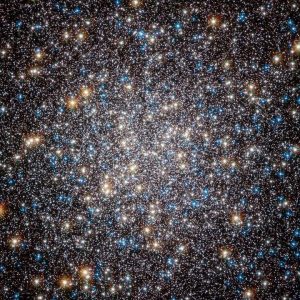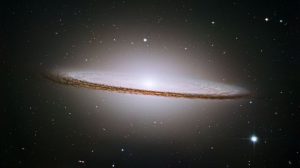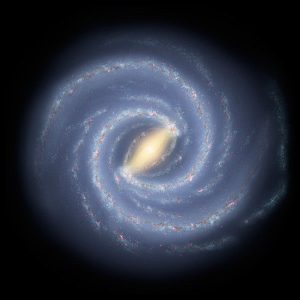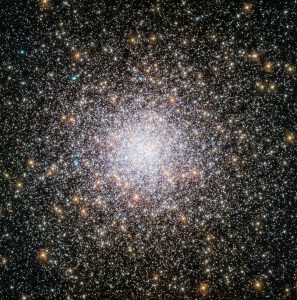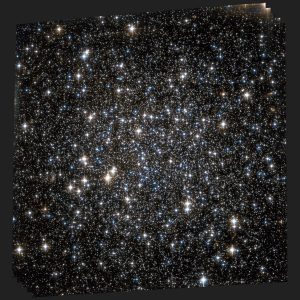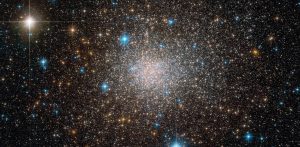ammasso globulare
Omega Centauri
L’enorme, scintillante insieme sferoidale di stelle immortalato in questa splendida immagine è più antico del nostro Sole. Molto prima che l’umanità si evolvesse, prima che i dinosauri vagassero per la Terra, e prima ancora persino che esistesse la nostra Terra, antichi ammassi di stelle orbitavano attorno ad una giovane Via Lattea. Continua a leggere
Il Fiume Oscuro verso Antares
Una nube fumosa chiamata Fiume Scuro (Dark River), che scorre dal bordo sinistro dell’immagine, collega la Nebulosa Pipa alla spettacolare regione colorata vicino alla stella brillante Antares. L’aspetto tenebroso del Fiume Scuro è dovuto alla presenza di polvere che blocca la luce stellare di fondo, sebbene la nube oscura contenga in gran parte idrogeno e gas molecolare. Continua a leggere
Nevicata di Stelle
Una nevicata stellare ammanta il centro del grande ammasso globulare Messier 13, immortalato in questa scintillante immagine del telescopio Hubble, permettendoci di ammirare una visione straordinariamente dettagliata delle centinaia di migliaia di stelle dell’ammasso, fra i più luminosi e noti in cielo. Continua a leggere
La Maestosa Galassia Sombrero
Ecco una delle galassie più imponenti e fotogeniche dell’Universo: la galassia Sombrero, Messier 104 (M104). Segno distintivo della galassia è un nucleo bianco brillante a bulbo circondato da spesse strisce di polvere che percorrono la struttura a spirale. Osservata dalla Terra, la galassia è inclinata quasi di taglio ed è stata chiamata Sombrero per la sua somiglianza con l’ampio cappello messicano. Continua a leggere
Una nuova famiglia di stelle nel cuore della Via Lattea
Un team di astronomi della Liverpool John Moores University ha individuato una nuova famiglia di stelle nel centro della Via Lattea. La scoperta può fornire indizi importanti sulla formazione e sulle origini della nostra galassia. Continua a leggere
Una casa per stelle antiche
Lo splendente ammasso globulare Terzan 1, una casa per stelle antiche, è situato a circa 20.000 anni luce dalla Terra nella costellazione dello Scorpione. Si tratta di uno dei circa 150 ammassi globulari appartenenti alla nostra galassia.
La Giovinezza di NGC 362
Gli ammassi globulari offrono una delle visioni più spettacolari nel cielo notturno. Queste sfere adorne di astri contengono centinaia di migliaia di stelle, e risiedono nelle periferie delle galassie. La Via Lattea ne contiene più di 150 e quello mostrato in questa nuova immagine del telescopio Hubble, chiamato NGC 362, è uno dei più inusuali. Continua a leggere
Centinaia di buchi neri nascosti
Secondo una recente ricerca dell’University of Surrey, pubblicata su Monthly Notices of the Royal Astronomical Society, un ammasso globulare potrebbe ospitare centinaia di buchi neri, un fenomeno che in precedenza si riteneva impossibile. Continua a leggere
Un raro resto fossile di una Via Lattea primordiale
Un team internazionale di astronomi ha scoperto un resto fossile di una primordiale Via Lattea, al cui interno si trovano stelle di età molto differenti. Questo sistema stellare, Terzan 5, a 19.000 anni luce di distanza dalla Terra, ricorda un ammasso globulare, ma è diverso dagli altri ammassi globulari conosciuti. Continua a leggere
Oggetti estremi: le pulsar millisecondo

Quando una stella con una massa di circa 10 volte quella solare termina la sua vita esplode in supernova, lasciandosi dietro come residuo una stella di neutroni. Le stelle di neutroni sono oggetti estremamente densi: possono avere una massa di poco maggiore a quella solare, ma concentrata in un diametro di qualche decina di chilometri. Continua a leggere
